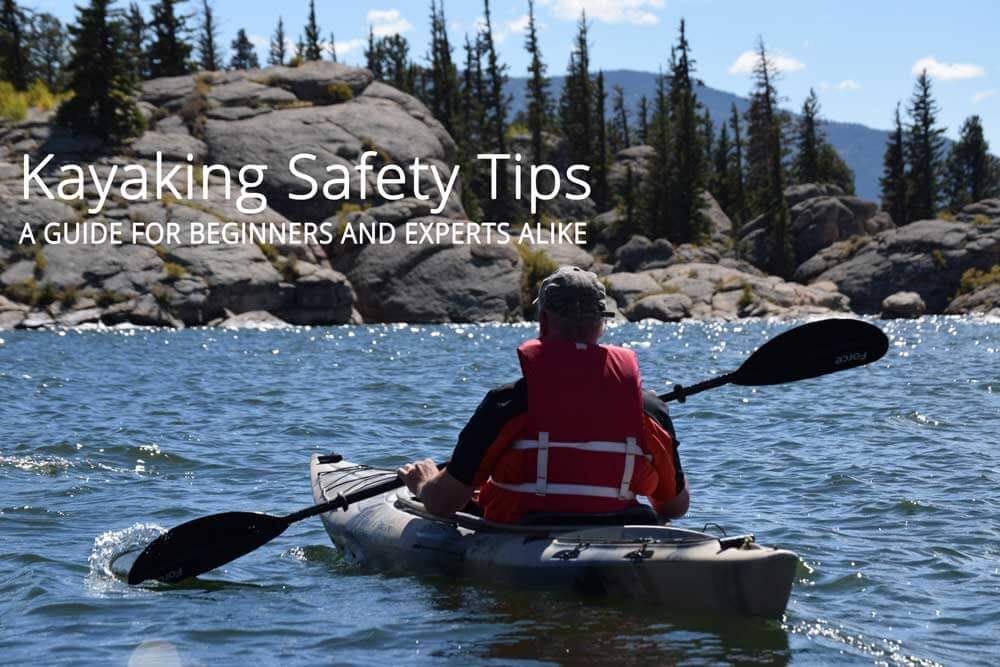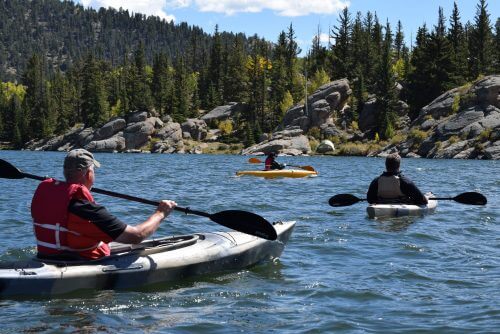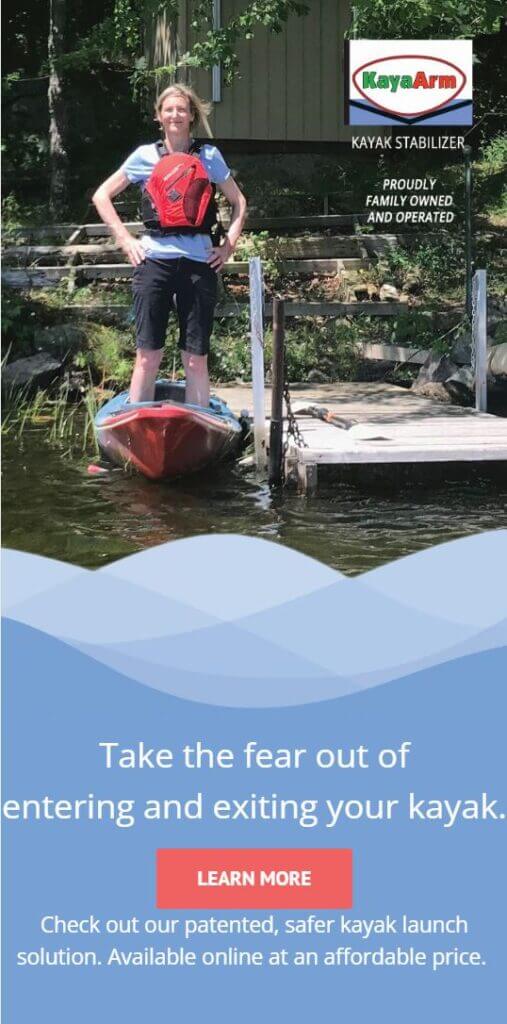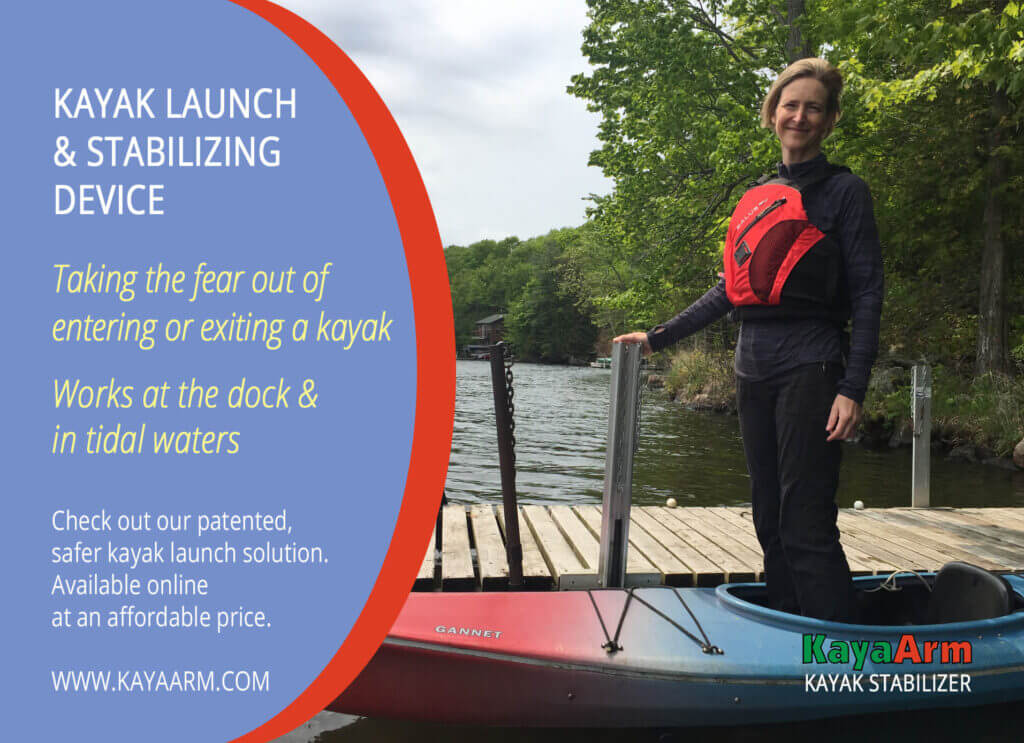

Kayak Safety Tips
We offer kayaking safety tips because kayaking is a fun watersport that lets you explore your natural surroundings in a whole new way. It has been around for a long time! You’ll get outside and get active but still have the freedom to set your own pace. Kayaking is perfect for beginners who want to float on the water and relax. It’s also an enjoyable and safe sport for older adults. And if you’ve been kayaking for years, you’ll always find new challenges to keep you coming back.
First-time or older kayakers may have a few safety concerns before stepping into a kayak. You might wonder where it’s safe to kayak, what you need to bring, or what to do if your kayak tips. But with a little practice, you’ll soon learn how to kayak safely and have a great day on the water.
Why Go Kayaking?
If you’ve never tried kayaking, there are lots of great reasons to go kayaking.

Kayak anywhere: One of the best things about kayaking is that you can do it anywhere. All you need is the right equipment and training. You can start your kayaking adventure from a dock or from shore, and explore a river, lake, or quiet bay. You can even take your kayak out on the ocean.
Kayak with friends: Unlike other water activities, kayaking is a great activity to do with family and friends. There are no loud motors, so you’ll be able to chat while you paddle. You can have a relaxed paddle on the lake or race your friends to the other shore.
Kayaking for exercise: Kayaking can be a great high-energy workout. However, it’s also a low-impact sport that won’t put a lot of pressure on your joints. This makes it a great watersport for older adults. Kayaking will also strengthen your arms, back, and core muscles, improving mobility and balance.
Things You Need to Go Kayaking
Before setting out on your next kayaking adventure, make sure you have everything you need for a fun and safe day on the water. The most important thing to bring is the kayak itself. Before you leave home, check your kayak carefully and look for any signs of damage. Then grab the rest of your gear.
Paddle: A great paddle is just as important as your kayak. The paddle length depends on your torso height. If your torso is longer than 28 inches, your paddle should be 200 centimeters or more. If your torso is shorter than 28 inches, make sure you have a shorter paddle.
Lifejacket: You should always wear a lifejacket when you’re kayaking. This is one of the most important pieces of safety equipment, and a lifejacket can save your life if you end up in the water.
Food and water: Have enough water for the day, and add a few snacks to your bag. You never know when you’ll need a bit of extra energy to paddle back to shore.
Bilge pump: If you have an enclosed kayak, it might fill with water when you’re kayaking. Having a bilge pump on board to empty your kayak will increase safety. This pump will empty the water out of your kayak in case of an emergency.
What Type of Kayak Should You Use?
There are several types of kayaks you can use. Which kayak you choose depends on your skill level, where you’re kayaking, and your personal preferences.
Touring Kayak
You’re probably thinking of a touring kayak when you picture a kayak. These are long kayaks with small, enclosed seats. They’re very narrow and perfect for a long trip across a lake.
Recreational Kayak
Recreational kayaks have larger openings that are easier to get into. They are also a bit shorter than touring kayaks, and they’re best for paddling on calm water.
Whitewater Kayak
If you’re heading out onto a fast-flowing river, a whitewater kayak is a good option. There are several kinds of whitewater kayaks, including river runners, creek boats, playboats, and longboats. Whitewater kayaks are for experienced kayakers.
Sit-On-Top Kayak
Sit-on-top kayaks are great for recreational use. These kayaks don’t have an enclosed seat, so you can easily scramble in and out of the kayak. They’re also more stable, so they’re safest for beginners.
Inflatable Kayak
Inflatable kayaks are a good choice for beginners. They’re very easy to transport, and they’re perfect for a lazy afternoon on the water with family and friends.

Kayaking Safely for Seniors
A key component of successful aging is exercise. Physical and mental exercise contribute to our well-being as we age. Kayaking is a great low-impact exercise for seniors that exercises the body and the mind.
Some reasons older adults give up kayaking include loss of mobility, loss of balance, and self-doubt, for example, concern about getting in and out of a kayak safely without tipping over. You can do many dry-land exercises before heading out on the water to help maintain or improve flexibility, mobility, and strength to continue enjoying kayaking.
Kayaking with Reduced Mobility or after Knee/Hip Surgery
Kayaking is a terrific form of rehabilitation after surgery, exercising your upper body without putting extra strain on your knees or hips after surgery. The KayaArm kayak launch system helps steady the kayak for those with reduced mobility, so you can still get in and out of a kayak safely.
There are even some modified techniques for getting into and out of a kayak using the KayaArm, so if you have significantly reduced mobility, you can still get in and out of your kayak safely.

Getting Into a Kayak with KayaArm
The launch system is perfect for beginners, older adults, and even expert kayakers. You’ll appreciate the simplicity of stepping into the kayak with the Launch Dock system. KayaArm makes it safe to get in and out of your kayak so you can enjoy a stress-free day on the water.
To increase your safety and make it even easier to get into your kayak from the dock, you can use the KayaArm Launch Dock system. This launch system stabilizes the kayak while entering or exiting, taking away the fear and worry of an unsteady kayak. It also gives you something to hold onto while you get in.
For more info on kayak launches, go to our kayak launch buyer’s guide.
KayaArm is the revolutionary new kayak launch stabilizing device that makes it safer to enter and exit your kayak at your dock. Getting into, launching and getting out of your kayak has never been this easy.
How to Get In and Out of a Kayak
You can’t learn to paddle a kayak until you know how to get in and out of your kayak. It’s important to learn how to get in and out of a kayak safely, whether you get in at the dock, from shore, or from open water.
Getting Into a Kayak From the Dock
If there’s a dock nearby, using the dock is one of the easiest and safest ways to get into your kayak. Here’s how to get into your kayak from a dock:
- Find the lowest part of the dock, where the surface of the dock is as close to the water as possible.
- Place your paddle on the side of the dock so its within reach.
- Lower your kayak carefully into the water, keeping it parallel to the dock.
- Sit on the edge of the dock and place your feet into the kayak. Swing your body to face the same direction as the kayak and lower yourself to sit in the seat.
Getting Into a Kayak From the Shore
If there’s no dock at your launching site, you can get into your kayak from shore. Whether you’re launching into a lake, river, or ocean, the steps for getting into your kayak are the same:
- Place your kayak on the shore as close to the water as possible.
- Get into your kayak and grab your paddle.
- Use your arms to push the kayak into the water.
Getting Into a Kayak From Open Water
The most challenging place to get into your kayak is from open water. However, for kayak safety, it’s important you know how to get back into your kayak in open water.
- Start by putting your paddle on the kayak so it doesn’t float away.
- Place one hand on the closest side of the kayak, then reach your other arm across the seat to the opposite side of the kayak.
- Pull yourself over the kayak so your stomach is over the seat and your lower legs are still in the water.
- Turn yourself over so you’re sitting sideways on the seat, with your feet still in the water.
- Stabilize the kayak, then pull your feet out of the water and turn your body so that you’re back in the kayak.
How to Get In and Out of a Kayak
You can’t learn to paddle a kayak until you know how to get in and out of your kayak. It’s important to learn how to get in and out of a kayak safely, whether you get in at the dock, from shore, or from open water.
Getting Into a Kayak From the Dock
If there’s a dock nearby, using the dock is one of the easiest and safest ways to get into your kayak. Here’s how to get into your kayak from a dock:
- Find the lowest part of the dock, where the surface of the dock is as close to the water as possible.
- Place your paddle on the side of the dock so its within reach.
- Lower your kayak carefully into the water, keeping it parallel to the dock.
- Sit on the edge of the dock and place your feet into the kayak. Swing your body to face the same direction as the kayak and lower yourself to sit in the seat.
Getting Into a Kayak From the Shore
If there’s no dock at your launching site, you can get into your kayak from shore. Whether you’re launching into a lake, river, or ocean, the steps for getting into your kayak are the same:
- Place your kayak on the shore as close to the water as possible.
- Get into your kayak and grab your paddle.
- Use your arms to push the kayak into the water.
Getting Into a Kayak From Open Water
The most challenging place to get into your kayak is from open water. However, one of the most important kayaking safety tips is that it’s important you know how to get back into your kayak in open water.
- Start by putting your paddle on the kayak so it doesn’t float away.
- Place one hand on the closest side of the kayak, then reach your other arm across the seat to the opposite side of the kayak.
- Pull yourself over the kayak so your stomach is over the seat and your lower legs are still in the water.
- Turn yourself over so you’re sitting sideways on the seat, with your feet still in the water.
- Stabilize the kayak, then pull your feet out of the water and turn your body so that you’re back in the kayak.
Getting Your Kayak out of the Water
Kayaks come in various styles, lengths, widths, and weights. Lifting your kayak from the water after a kayak trip can be a challenge, no matter the shape or size of the kayak. Kayakers with reduced upper body strength can enjoy kayaking, but hoisting the kayak from the water can be difficult.
Using two KayaArms enables you to easily lift your kayak out of the water without bending over and putting extra strain on your back or arms. It also allows you to store your kayak beside the dock, eliminating the need to carry it onto the dock or to the shore for storage.
Tips for Safe Kayaking
Kayaking is an incredibly versatile sport. You can relax on a calm lake or have a fast-paced adventure in whitewater rapids. Whatever kind of kayaking you prefer, it’s important to learn about kayaking safety and safety hazards before stepping into your kayak.
Wear a Lifejacket
You should wear a lifejacket for kayak safety, even if you’re a strong swimmer. Wearing a life jacket can keep you safe when the unexpected happens, so always wear your life jacket.
Dress for Submersion
When you go kayaking, remember there’s always a chance you could end up in the water. Always dress for submersion, especially if you’re kayaking in cold water.
Paddle in Conditions That Match Your Skills
An important safety tip is to paddle in weather and water conditions that match your current skill level. If you’re a beginner, stay close to shore and kayak in calm weather conditions. Don’t head out into deep water alone, and try to stay close enough that you could swim to shore if necessary.
Don’t Drink and Kayak
It’s never a good idea to drink when doing any sports that could put your safety at risk. Don’t drink and kayak if you’re kayaking far from shore, on a river, or in rough conditions.
How to Right Yourself in a Kayak
Kayaking safety is all about being prepared for any situation. It’s important to know how to right yourself in a kayak in case the kayak flips. If your kayak flips in calm water, don’t panic. Flip the kayak back over, and go through the steps to re-enter your kayak from open water.
If your kayak flips in a strong current, you may not be able to flip the kayak or get back in. Hold the kayak with one arm, and swim back to shore. Using a backstroke is best, so it’s easier to keep your head above water.
How Easy Is It to Flip a Kayak?
It’s important to be prepared in case your kayak flips, but it’s actually quite difficult to flip a kayak. Kayaks were designed with safety in mind, and they’re hard to flip. It’s unlikely your kayak will flip if you’re kayaking in calm water. You can also prevent your kayak from flipping by staying in the center of your kayak and always wearing a lifejacket.
Practice Kayak Re-Entry
Before you head out kayaking in open water, experts recommend practicing flipping your kayak as well as kayak re-entry. You’ll build confidence when you learn to re-enter your kayak near the shore safely. You can also work with a kayaking instructor to learn how to roll your kayak and flip your kayak without getting out.
The Best Weather for Kayaking
If you’re heading out in the kayak, be sure to check the weather before heading out on the water. The best weather for kayaking safety is warm and dry weather, with little or no wind and calm water. If possible, avoid the following weather conditions:
- Stormy weather
- Windy weather that causes rough water
- Foggy weather that reduces visibility
Spur-of-the-moment kayaking trips can be exciting, but it’s unsafe if the forecast predicts bad weather.
How to Stay Safe When the Weather Changes
Weather patterns can change quickly, and even if you expect a beautiful day, you may find yourself kayaking during a sudden weather change. Stay safe by staying alert. Watch for any clouds on the horizon, and notice if the wind changes. If the weather begins changing, get to shore as soon as possible.
However, if the wind is against you or you lose control of your kayak, don’t fight it. Think about driving on a patch of ice and trying to regain control of your car. Overcorrecting can make the situation more dangerous, and letting the car slide is sometimes safer. When kayaking in bad weather, stay safe by moving with the kayak, and try not to overcorrect to stay in control.
Kayaking Safety Checklists
Kayaking safety starts with being prepared. Use these safety checklists to make sure you’re ready for your next kayaking adventure.
Know Before You Go
When you head out kayaking,
ask yourself and your friends these questions:
- Can everyone swim in open water?
- Have you checked your kayak and all your equipment to make sure everything is in working order?
- Does the location and the conditions match your skill level?
- Did you research any hazards in the location, like strong currents or rocks near the surface of the water?
- Have you told a family member or friend your plan, and where you’re going kayaking?
- Did you check the weather?
- Are you prepared in case the weather changes suddenly?
- Do you have an emergency plan in place?
Answering all the questions will help you stay safe while kayaking.
Safety Items for Your Next Kayaking Trip
Kayaking safety isn’t just about skill. There are a few items you’ll need to stay safe on the water.
- Lifejacket
- Helmet if kayaking in rough water
- Hat for sun protection
- Sunscreen
- A spare paddle
- Clothing for submersion
- A whistle or other signaling device
- Drybag to pack your essentials
- Your phone or emergency satellite phone
- A map or compass to stay on track
- Water and extra snacks
Use this checklist to make sure you have everything you need for kayaking safety. Pack these items for your next kayaking trip, along with any other protective equipment you might need for the location or weather conditions.
Kayak Tips for Beginners
Are you trying kayaking for the first time? These are a few tips to help you stay safe as you learn to kayak.
Start on a lake: It’s a good idea to start kayaking on a lake or a very calm body of water. Find a lake that doesn’t have too much water traffic or power boats that may create a lot of waves.
Kayak with others: For kayaking safety, kayak with friends or family when you’re first starting out. You can also kayak close to shore and stay within sight of family and friends on the beach. If you need help, your friends will be close by, and you can stay safe while kayaking.
Take short trips: It takes a while for beginners to build up muscle strength and confidence for long trips. Start with short trips and don’t be overly ambitious on your first few kayaking trips. It’s better to paddle along the shore on your first trips rather than paddling far out into the middle of the lake. Keep your first trips to under an hour, and slowly build up confidence and skill.
Launch Your Kayak with Ease
Kayaking is a fun and enjoyable sport for everyone. Whether you’re a beginner or a seasoned pro, kayaking safety should be a top priority. If you’re launching your kayak from a dock, we can help you make your kayaking adventure start safely.
The KayaArm is very easy to assemble and install on virtually any type of dock. It is built to stand up to years of use, even in salt water. Once installed, the arm of the KayaArm that stabilizes your kayak is infinitely adjustable for changes in water level, so it is always at the optimum height to stabilize your kayak while you are getting in or out.
It is as simple as floating the bow of your kayak over the arm and stepping down into your kayak. Your weight and downward force will steady the kayak on the arm as you sit down. Once seated, grab your paddle, push off and enjoy your kayak trip!
When you return, bring your kayak bow over the arm again, bring your heels towards the seat, push down with your hands and stand up. You can safely step out of your kayak onto the dock. KayaArm also makes it easy to lift your kayak from the water, and our systems can even be used for kayak storage at the dock or in the garage.
Get ready to head out onto the water and follow these safety tips on your next kayaking adventure.
